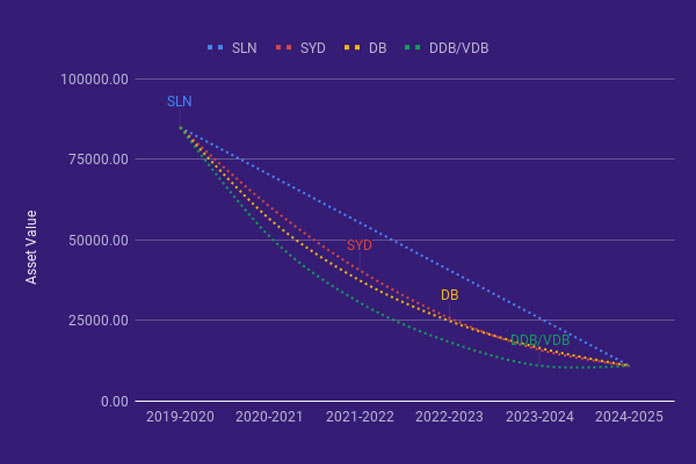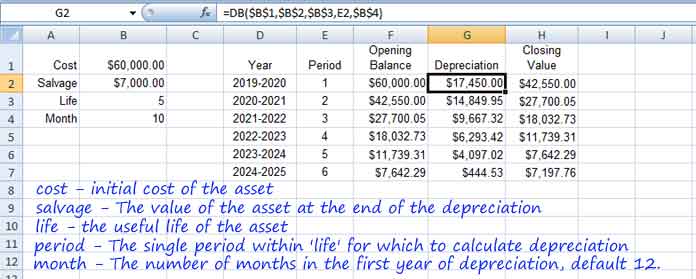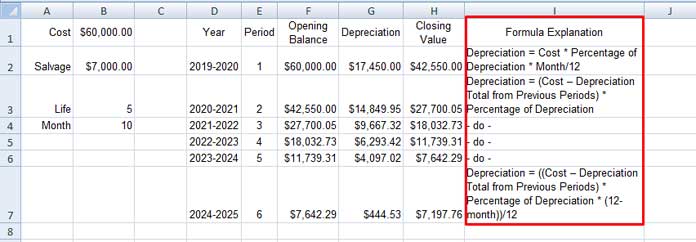Recently I have posted a tutorial on the use of Google Sheets DB function. That time, during my research, I came to know that the same function is slightly different in Excel. So here in this DB in Excel vs DB in Google Sheets comparison I am going to point out that difference.
Other depreciation functions like SLN, SYD, DDB and VDB work similar in Excel and Google Sheets. So there is no scope of comparison.
Want to learn these financial functions? Then please do check my Google Sheets Functions Guide.
I don’t know which depreciation method you follow in your company or for depreciating your own asset like a car, laptop, etc. You may find this chart useful. See the curves.

| A | B | |
| 1 | Initial Cost of Asset | $85,000.00 |
| 2 | Salvage (scrap value) | $11,000.00 |
| 3 | Life (the useful life) | 5 |
Since I have already posted the use of DB in Google Sheets, let me introduce you the DB function in Excel. Then we can go to the comparison.
How to Use the DB Depreciation Function in Excel
The syntax of the DB function in Excel and Google Sheets is the same.
Syntax:
DB(cost, salvage, life, period, [month])I hope you already know the arguments in this function. It’s almost the same in all the depreciation functions.
If you have any doubt, please do check my tutorial on financial functions or see the image below.
DB Formula Example in Excel
See the formulas used in the below example.

I have used the following formula in cell G2.
=DB($B$1,$B$2,$B$3,E2,$B$4)In this formula, cell reference B1, B2, B3, and B4 represents the cost of the asset, salvage (scrap) value, the useful life of the asset and the number of months in the first year respectively.
When I drag this formula down, these cell references will remain the same as they are absolute cell references.
The cell E2 which refer to ‘period’ used in this formula is relative. So when you drag down the period in the formula changes from 1 to 2, 3 and so on.
Related: Placement and Use of Single or Double Dollar Symbols in Formulas.
This way the formula returns the depreciation amount for different periods in column G.
Now let’s see how the DB formula in Excel differs in Google Sheets.
DB in Excel Vs DB in Google Sheets – Formula Comparison
I am going to use the same sample data and formulas in Google Sheets.

See the #NUM! error in the cell G7 and H7. Point your mouse over the error to see the tool tip.
You can understand that the error is because of parameter 4 in the formula which is the ‘period’.
DB(cost (1), salvage (2), life (3), period (4), [month])Parameter 4 value is 6 (cell E7). The useful life of the asset is 5 years only. That means the parameter 4 value should be less than or equal to the parameter 3 value which is 5.
Then why Excel returns no error in this case?
DB Generic Formula in Excel and Google Sheets
Excel uses the below formula to calculate the DB except for the first and last period. But in Google Sheets, the formula is the same except for the first period.
Depreciation = (Cost – Depreciation Total from Previous Periods) * Percentage of DepreciationIn this the ‘Percentage of Depreciation’ is ;
Percentage of Depreciation = 1 – ((salvage / initial cost) ^ (1 / life))This output must be round to 3 decimal places.
For the first period Excel and Google Sheets uses the below formula.
Depreciation = Cost * Percentage of Depreciation * Month/12For the last period Excel uses this formula.
Depreciation = (Cost * Percentage of Depreciation * (12-month))/12DB – Sheets Manual Calculation for All the Periods:

DB – Excel Manual Calculation for All the Periods:

I hope you have found this DB in Excel vs DB in Google Sheets comparison useful. If you switch from Excel to Sheets, definitely or vice versa, you must know such function differences.





















